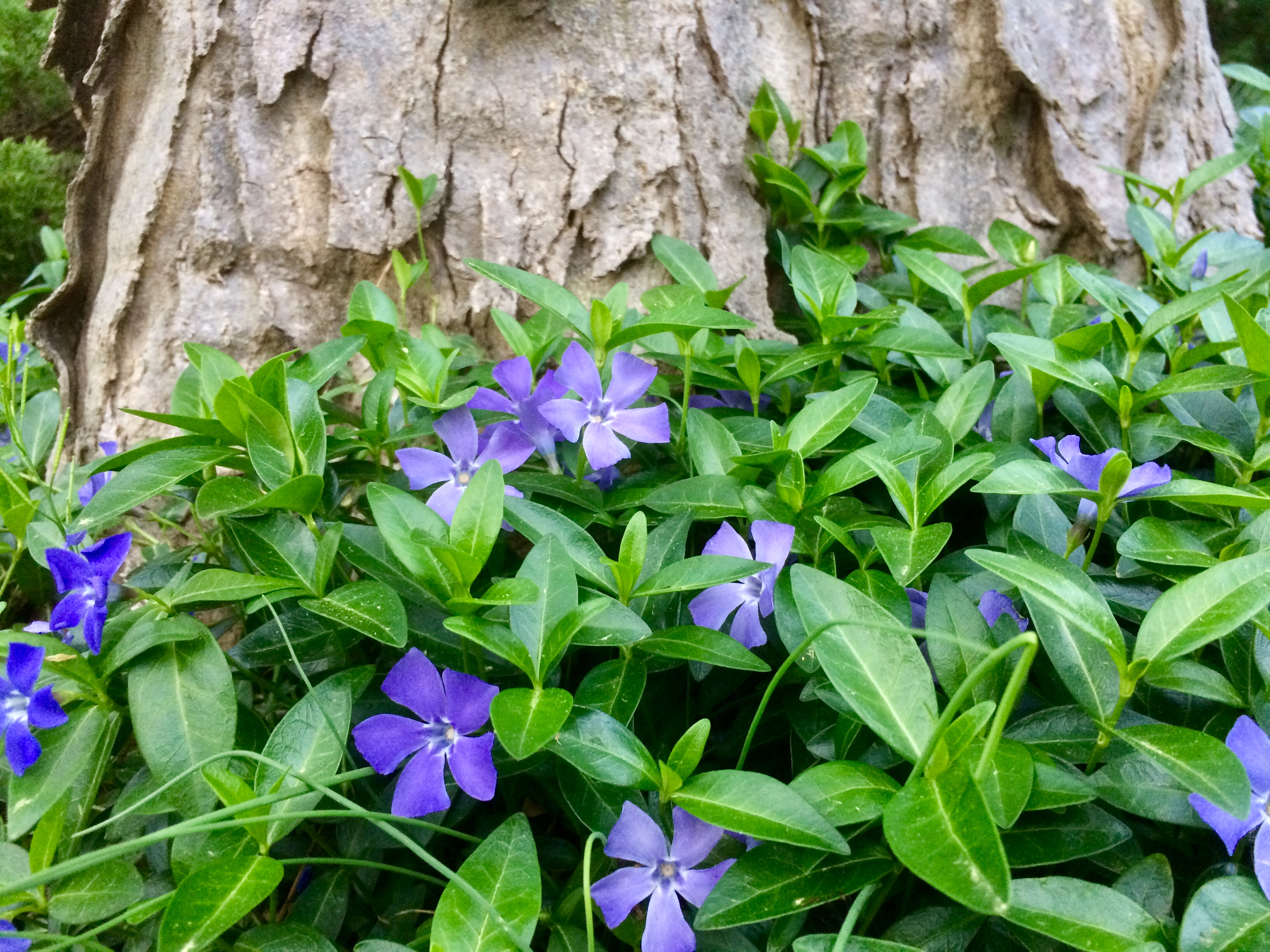Groundcovers

When a groundcover is properly situated in the soil and light conditions it prefers, it spreads most agreeably. However, even the best groundcovers, such as sweet woodruff, often have to be controlled. Most groundcovers that spread by stolons or underground stems can be controlled in gardens by installing edging. An edging strip, such as landscape timbers or inconspicuous vinyl lawn borders sunk into the ground, will keep your groundcovers from trying to find out if the grass is really greener on the other side.
General Spacing
Most of the varieties listed are recommended to be planted anywhere from 1 to 2 feet apart for good coverage; although planting closer together will fill in the area faster.
Care & Maintenance
After the initial planting, be sure to keep the plants well watered and mulched to keep them from drying out and to prevent unwanted weeds from taking over the planting.
Periwinkle (Vinca Minor)
Periwinkle, also known as Creeping Myrtle, will grow in part sun or deep shade, in moist or dry soil conditions, and even in the densest shade, where little else will grow. Once filled in, which it does quickly, it practically defies weeds. Enjoy evergreen foliage all year long and periwinkle blue flowers in the early spring.
Tips for Planting Periwinkle
- Remove existing sod, grass, weeds, etc.
- Rototill or spade area to a depth of 8”.
- Add Canadian Peat Moss 2” thick over entire area (1 cu. ft. of peat will cover 12 sq. ft. of ground area at 2” thick.
- Add Perlite 1” thick over entire area (1 cu. ft. Perlite covers 12 sq. ft. at 1” thick).
- Rototill or spade into soil until uniformly mixed.
- Rake area until it’s even as possible.
- Position plants to desired coverage and plant. (See spacing and coverage guide).
- Plant potted plants with 1/2” of soil level above ground level and rooted cuttings so that top roots are ground level to allow for mulching.
- We suggest using a pre-emergent annual weed and grass control like Preen.
- Mulch with 1 1/2” of Right Dress, hardwood bark, or other suitable mulch.
Periwinkle Maintenance Tips
- Keep area moist during the first growing season, to fully establish plants before winter.
- Feed with Esbenshade's Transplant Root Stimulator during the first growing season.
- Feed established plantings with an appropriate dry granular fertilizer such as Holly Tone, or liquid ‘touch up’ fertilizer such as Miracid.
Periwinkle Coverage and Spacing Guide
- Plant, Plants Per Spacing Square Foot
- 12” on center 1 plant per sq. ft.
- 8” on center 2 plants per sq. ft.
- 6” on center 4 plants per sq. ft.
The following lists contain a variety of groundcovers suitable for sunny areas as well as shady areas of the garden.
Groundcovers for Shady AreasAegopodium – Snow on the Mountain
Ajuga Reptans – Bugleweed
Arenaria verna – Moss Sandwort
Asarum spp. – Wild Gingers
Astilbe chinensis – Dwarf Astilbe
Bergenia spp. – Heart Bergenia
Cerostigma plumbago – Leadwort
Chrysogonum spp. – Goldenstar
Convallaria majalis – Lily of the Valley
Epimedium spp. – Barrenwort
Euonymous fortunei – Wintercreeper
Ferns – (many varieties)
Galium odoratum – Sweet Woodruff
Gaultheria procumbens – Wintergreen
Hedera helix – English Ivy
Helleborous – Hellebore
Hosta spp. – Plaintain lily
Hypericum calycinum – St. John’s Wort
Iris cristata – Dwarf Crested Iris
Lamiastrium – Golden Archangel
Lamium – Spotted Dead Nettle
Liriope spp. – Lilyturf
Pachysandra spp. – Spurge
Phlox stolonifera – Creeping Phlox
Pulmonaria – Lungwort
Tiarella – Foamflower
Vinca minor – Periwinkle
Viola – Violets
Waldesteinia – Barren Strawberry
Groundcovers for Sunny Areas
Achillea tomentosa – Wooly Yarrow
Alchemilla mollis – Lady’s Mantle
Arabis spp. – Rock Cress
Armeria maritime – Sea Thrift
Artemesia spp. – Wormwood
Campanula carpatica – Bellflower
Cerastium tomentosum – Snow in Summer
Coreopsis spp. – Tickseed
Delosperma – Hardy Ice Plant
Dianthus spp. – Pinks
Euphorbia polychroma – Cushion Spruge
Festuca – Blue Fescue Grass
Fragaria – Alpine Strawberry
Geranium spp. – Hardy Cranesbill
Gypsophilia repens – Creeping Baby's Breath
Helianthemum – Rock Rose
Hemerocallis spp. – Daylilies
Houttuynia – Chameleon Plant
Iberis – Candytuft
Lavendula spp. – Lavender
Lysimachia nummularia – Moneywort
Nepeta spp. – Catmint
Oenothera spp. – Evening Primrose
Phlox subulata – Creeping Phlox
Sedum spp. – Stonecrop
Sempervivium – Hen’s and Chicks
Stachys lanata – Lamb’s Ear
Thymus – Thyme
Veronica spp. – Speedwell
